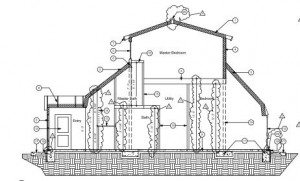
If you are familiar with the Small or Tiny House movement, inspired by the book The Not So Big House (1997) by Sarah Susanka, you probably know that one of the core values of this movement is achieving quality over quantity. The Small House Organization is “dedicated to the promotion of smaller housing alternatives which can be more affordable and ecological” . We are thankful to the movement for many reasons, primarily because they have helped thousands of people think more creatively about the homes that they live in, or plan to live in. The movement has helped many to think more purposefully about their homes. During the 2007-08 economic meltdown, tens of 1.000’s of people in the U.S. started to question consumer consumption, for the sake of consumption. Forward thinking folks began to plan for a life of creating “more with less”. The Small House movement is a product of that shift and it isn’t getting less attention now that our U.S. economy is on the upswing. Even so, studies show that less than 1% of people living in the U.S. live in homes under 1,000sf. I wonder how many of that number do so voluntarily? The reasons why this movement holds a certain amount of romanticism if obvious. The reasons why so few people live the Tiny House life, is pretty obvious as well.
The Haven™ is not a Small House. Our Haven™ model home is the 3 bedroom/ 2 bath model. In this model, we have easy access to an additional 400 sf. of storage. Essentially, we are heating and cooling 2000 sf., contained in the exterior shell that uses about 1100 sf. of building material.
We created the Haven™ design to be different than Small or Tiny Houses in 5 important ways:
- Conventional living space and conventional furniture placement
- The Haven™ home is permanent, durable, and will appreciate and depreciate in sync with the property value.
- Ability to be insured with Homeowner’s Insurance
- Ability to be financed as a custom home
- All applicable building (and most importantly) safety codes apply
The Haven™ home is in sync with Small or Tiny House principles in 5 distinct ways:
- Maximum potential of all interior space by minimizing frivolous space
- Establishment of as much multipurpose space as possible
- Prevalent and natural use of ecologically friendly materials
- Efficient and minimal use of non-renewable resources
- Quality over quantity
5 Haven™ Spaces That Offer Maximum Utilitarian Value
- The bedroom off the living room is a comfortable office-sitting area, except for the few times a year that we need the twin trundle beds for overflow guests. The double French doors that separate it from the living room stay open most of the time. Recently we had an open house with 50 guests coming and going. For an hour or so, most were in the home chatting and milling about. The office served as an extension of the living room and helped to spread out small groups of visitors. As I write this, Greg is lounging on the sectional sofa yelling at the basketball game so I’ve closed the doors and dropped the insulated blinds, making it pretty easy for me to tune him out. By enclosing this area, we were able to utilize the area above the ceiling for a closet.
- Our kitchen is large enough to allow for a table/island that doubles as additional counter space. It’s a little higher than a standard table and just a little lower than our granite counter. When we cook, it serves as a landing for items removed from the fridge, or those that are lined up to put back. We added casters to our table so that we can pull it closer to the counter when needed, but push it closer to the door when we are enjoying dinner with guests. During Christmas time, we cooked together and had 9 around the table. It was certainly more snug than the big dining room we had in our old home. That dining room sat empty all but a few nights a year, but we paid the same amount to build it as the rest of our home, and paid for heating and cooling year round!
- In the downstairs bath, counter top space is at a premium, but access to space under the stairs was available. We snagged that for a bullet of drawers. Built in glass shelves behind the sink give us enough additional space to place some wash cloths, lotion, and whatever else is handy within reaching distance of the sink
- In the upstairs bath, we compromised with the space available. We decided to give up a vanity and share one. After 35 years of having our own sinks, it was surprisingly easy! The trade-off was a master shower that is approx. 36” wide by 58” long. We can have a bench and two shower heads in our master shower.
- The Haven only has one hallway. This is a space that is only used to reach the back closet and pantry under the stairs. Access to the guest bedroom, for guests, is just about always through the bathroom. The trade-off was getting a bigger downstairs/guest bath (a space that’s used most days) by minimizing the width of the hall.
When designing your own space, spend some time thinking about the Economy of Space. What areas of your home do you use more, and less? How can you maximize the potential of the space you have to work with? All homes can use this creative way of thinking to get more for less.





You must be logged in to post a comment.